EU-Singapore FTA and its Effects on Singapore's Economy: Report
VerifiedAdded on 2021/06/17
|12
|2865
|24
Report
AI Summary
This report examines the EU-Singapore Free Trade Agreement (EUSFTA), analyzing its potential impacts on Singapore's economy within the context of global trade and economic integration. It begins with an introduction to the evolving global business environment, highlighting the significance of trade liberalization and interconnectedness. The report summarizes a news article discussing the EUSFTA, which is expected to come into effect by 2019, and then provides an overview of both the European Union and Singapore, including their economic structures and trade relationships. It delves into the trade dynamics between the EU and Singapore, including export and import figures, and foreign direct investment flows. The report further discusses the effects of the EU's economic environment on Singapore's prosperity and outlines the aims and expected implications of the EUSFTA, such as the removal of custom duties, trade facilitation, and investment encouragement. Overall, the report emphasizes the importance of the agreement in strengthening economic ties and promoting growth for both entities.

Running head: ECONOMIC POLICY AND GLOBAL ENVIRONMENT
Economic Policy and Global Environment
Name of the Student
Name of the University
Author Note
Economic Policy and Global Environment
Name of the Student
Name of the University
Author Note
Paraphrase This Document
Need a fresh take? Get an instant paraphrase of this document with our AI Paraphraser
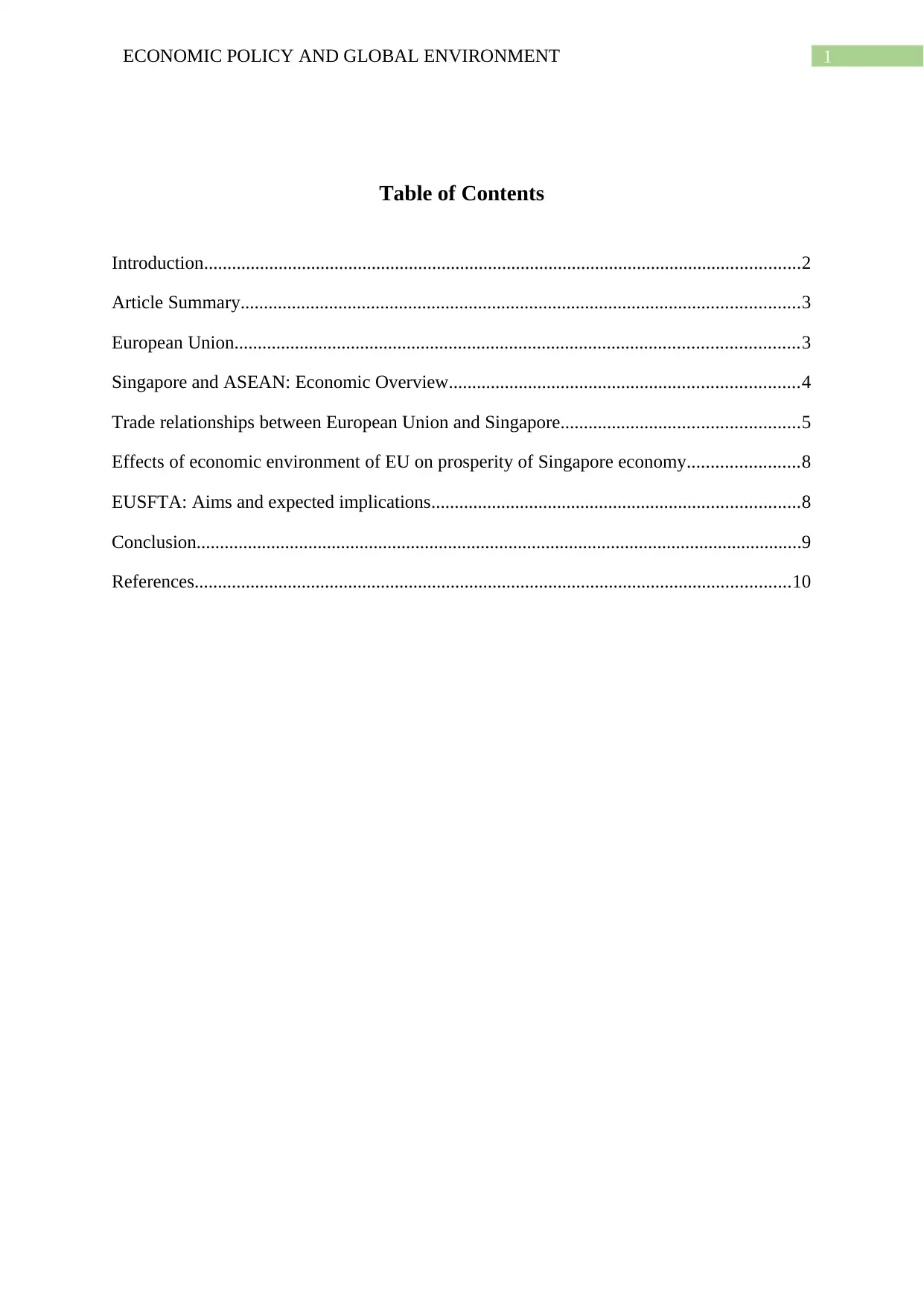
1ECONOMIC POLICY AND GLOBAL ENVIRONMENT
Table of Contents
Introduction................................................................................................................................2
Article Summary........................................................................................................................3
European Union.........................................................................................................................3
Singapore and ASEAN: Economic Overview...........................................................................4
Trade relationships between European Union and Singapore...................................................5
Effects of economic environment of EU on prosperity of Singapore economy........................8
EUSFTA: Aims and expected implications...............................................................................8
Conclusion..................................................................................................................................9
References................................................................................................................................10
Table of Contents
Introduction................................................................................................................................2
Article Summary........................................................................................................................3
European Union.........................................................................................................................3
Singapore and ASEAN: Economic Overview...........................................................................4
Trade relationships between European Union and Singapore...................................................5
Effects of economic environment of EU on prosperity of Singapore economy........................8
EUSFTA: Aims and expected implications...............................................................................8
Conclusion..................................................................................................................................9
References................................................................................................................................10
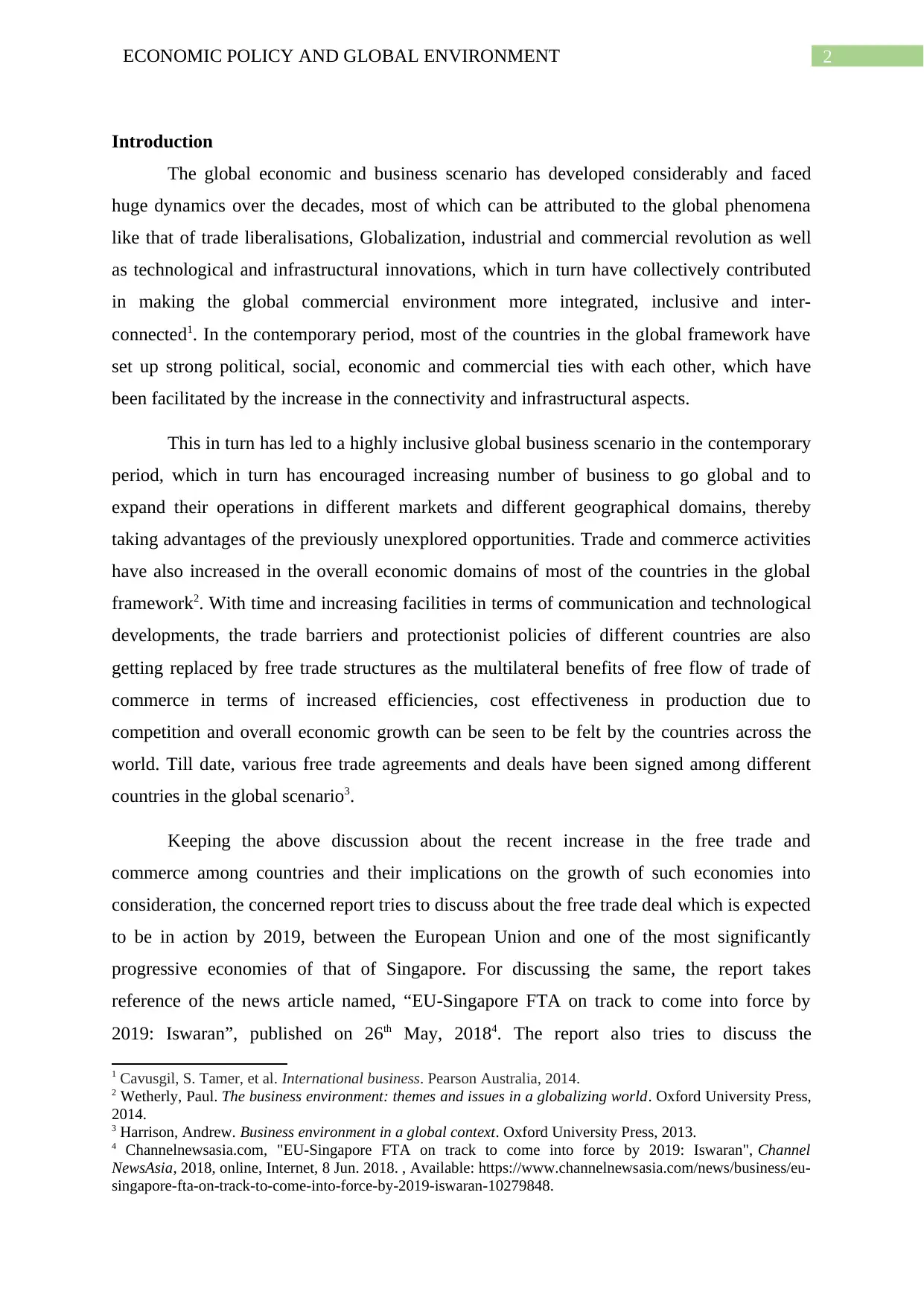
2ECONOMIC POLICY AND GLOBAL ENVIRONMENT
Introduction
The global economic and business scenario has developed considerably and faced
huge dynamics over the decades, most of which can be attributed to the global phenomena
like that of trade liberalisations, Globalization, industrial and commercial revolution as well
as technological and infrastructural innovations, which in turn have collectively contributed
in making the global commercial environment more integrated, inclusive and inter-
connected1. In the contemporary period, most of the countries in the global framework have
set up strong political, social, economic and commercial ties with each other, which have
been facilitated by the increase in the connectivity and infrastructural aspects.
This in turn has led to a highly inclusive global business scenario in the contemporary
period, which in turn has encouraged increasing number of business to go global and to
expand their operations in different markets and different geographical domains, thereby
taking advantages of the previously unexplored opportunities. Trade and commerce activities
have also increased in the overall economic domains of most of the countries in the global
framework2. With time and increasing facilities in terms of communication and technological
developments, the trade barriers and protectionist policies of different countries are also
getting replaced by free trade structures as the multilateral benefits of free flow of trade of
commerce in terms of increased efficiencies, cost effectiveness in production due to
competition and overall economic growth can be seen to be felt by the countries across the
world. Till date, various free trade agreements and deals have been signed among different
countries in the global scenario3.
Keeping the above discussion about the recent increase in the free trade and
commerce among countries and their implications on the growth of such economies into
consideration, the concerned report tries to discuss about the free trade deal which is expected
to be in action by 2019, between the European Union and one of the most significantly
progressive economies of that of Singapore. For discussing the same, the report takes
reference of the news article named, “EU-Singapore FTA on track to come into force by
2019: Iswaran”, published on 26th May, 20184. The report also tries to discuss the
1 Cavusgil, S. Tamer, et al. International business. Pearson Australia, 2014.
2 Wetherly, Paul. The business environment: themes and issues in a globalizing world. Oxford University Press,
2014.
3 Harrison, Andrew. Business environment in a global context. Oxford University Press, 2013.
4 Channelnewsasia.com, "EU-Singapore FTA on track to come into force by 2019: Iswaran", Channel
NewsAsia, 2018, online, Internet, 8 Jun. 2018. , Available: https://www.channelnewsasia.com/news/business/eu-
singapore-fta-on-track-to-come-into-force-by-2019-iswaran-10279848.
Introduction
The global economic and business scenario has developed considerably and faced
huge dynamics over the decades, most of which can be attributed to the global phenomena
like that of trade liberalisations, Globalization, industrial and commercial revolution as well
as technological and infrastructural innovations, which in turn have collectively contributed
in making the global commercial environment more integrated, inclusive and inter-
connected1. In the contemporary period, most of the countries in the global framework have
set up strong political, social, economic and commercial ties with each other, which have
been facilitated by the increase in the connectivity and infrastructural aspects.
This in turn has led to a highly inclusive global business scenario in the contemporary
period, which in turn has encouraged increasing number of business to go global and to
expand their operations in different markets and different geographical domains, thereby
taking advantages of the previously unexplored opportunities. Trade and commerce activities
have also increased in the overall economic domains of most of the countries in the global
framework2. With time and increasing facilities in terms of communication and technological
developments, the trade barriers and protectionist policies of different countries are also
getting replaced by free trade structures as the multilateral benefits of free flow of trade of
commerce in terms of increased efficiencies, cost effectiveness in production due to
competition and overall economic growth can be seen to be felt by the countries across the
world. Till date, various free trade agreements and deals have been signed among different
countries in the global scenario3.
Keeping the above discussion about the recent increase in the free trade and
commerce among countries and their implications on the growth of such economies into
consideration, the concerned report tries to discuss about the free trade deal which is expected
to be in action by 2019, between the European Union and one of the most significantly
progressive economies of that of Singapore. For discussing the same, the report takes
reference of the news article named, “EU-Singapore FTA on track to come into force by
2019: Iswaran”, published on 26th May, 20184. The report also tries to discuss the
1 Cavusgil, S. Tamer, et al. International business. Pearson Australia, 2014.
2 Wetherly, Paul. The business environment: themes and issues in a globalizing world. Oxford University Press,
2014.
3 Harrison, Andrew. Business environment in a global context. Oxford University Press, 2013.
4 Channelnewsasia.com, "EU-Singapore FTA on track to come into force by 2019: Iswaran", Channel
NewsAsia, 2018, online, Internet, 8 Jun. 2018. , Available: https://www.channelnewsasia.com/news/business/eu-
singapore-fta-on-track-to-come-into-force-by-2019-iswaran-10279848.
⊘ This is a preview!⊘
Do you want full access?
Subscribe today to unlock all pages.

Trusted by 1+ million students worldwide
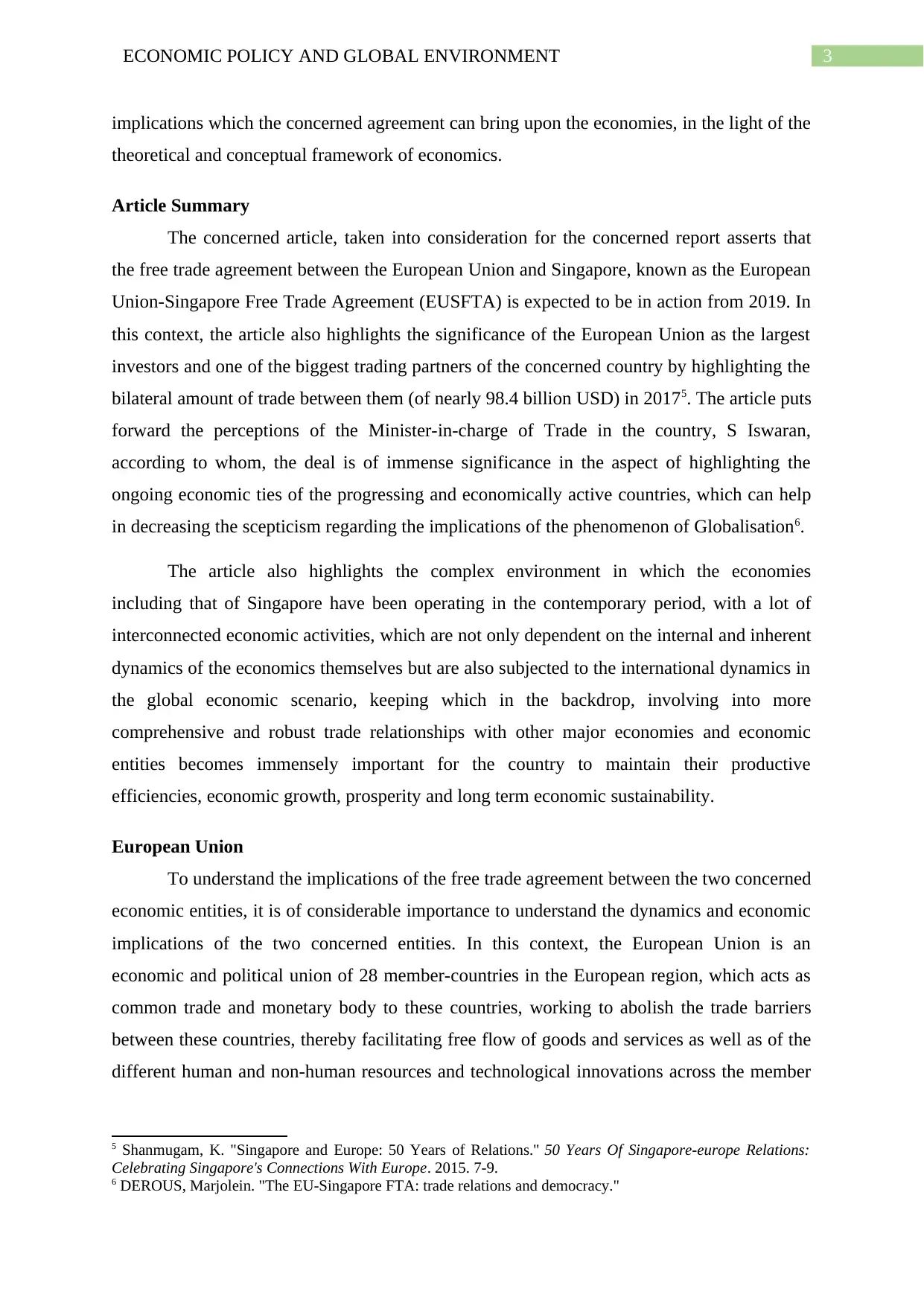
3ECONOMIC POLICY AND GLOBAL ENVIRONMENT
implications which the concerned agreement can bring upon the economies, in the light of the
theoretical and conceptual framework of economics.
Article Summary
The concerned article, taken into consideration for the concerned report asserts that
the free trade agreement between the European Union and Singapore, known as the European
Union-Singapore Free Trade Agreement (EUSFTA) is expected to be in action from 2019. In
this context, the article also highlights the significance of the European Union as the largest
investors and one of the biggest trading partners of the concerned country by highlighting the
bilateral amount of trade between them (of nearly 98.4 billion USD) in 20175. The article puts
forward the perceptions of the Minister-in-charge of Trade in the country, S Iswaran,
according to whom, the deal is of immense significance in the aspect of highlighting the
ongoing economic ties of the progressing and economically active countries, which can help
in decreasing the scepticism regarding the implications of the phenomenon of Globalisation6.
The article also highlights the complex environment in which the economies
including that of Singapore have been operating in the contemporary period, with a lot of
interconnected economic activities, which are not only dependent on the internal and inherent
dynamics of the economics themselves but are also subjected to the international dynamics in
the global economic scenario, keeping which in the backdrop, involving into more
comprehensive and robust trade relationships with other major economies and economic
entities becomes immensely important for the country to maintain their productive
efficiencies, economic growth, prosperity and long term economic sustainability.
European Union
To understand the implications of the free trade agreement between the two concerned
economic entities, it is of considerable importance to understand the dynamics and economic
implications of the two concerned entities. In this context, the European Union is an
economic and political union of 28 member-countries in the European region, which acts as
common trade and monetary body to these countries, working to abolish the trade barriers
between these countries, thereby facilitating free flow of goods and services as well as of the
different human and non-human resources and technological innovations across the member
5 Shanmugam, K. "Singapore and Europe: 50 Years of Relations." 50 Years Of Singapore-europe Relations:
Celebrating Singapore's Connections With Europe. 2015. 7-9.
6 DEROUS, Marjolein. "The EU-Singapore FTA: trade relations and democracy."
implications which the concerned agreement can bring upon the economies, in the light of the
theoretical and conceptual framework of economics.
Article Summary
The concerned article, taken into consideration for the concerned report asserts that
the free trade agreement between the European Union and Singapore, known as the European
Union-Singapore Free Trade Agreement (EUSFTA) is expected to be in action from 2019. In
this context, the article also highlights the significance of the European Union as the largest
investors and one of the biggest trading partners of the concerned country by highlighting the
bilateral amount of trade between them (of nearly 98.4 billion USD) in 20175. The article puts
forward the perceptions of the Minister-in-charge of Trade in the country, S Iswaran,
according to whom, the deal is of immense significance in the aspect of highlighting the
ongoing economic ties of the progressing and economically active countries, which can help
in decreasing the scepticism regarding the implications of the phenomenon of Globalisation6.
The article also highlights the complex environment in which the economies
including that of Singapore have been operating in the contemporary period, with a lot of
interconnected economic activities, which are not only dependent on the internal and inherent
dynamics of the economics themselves but are also subjected to the international dynamics in
the global economic scenario, keeping which in the backdrop, involving into more
comprehensive and robust trade relationships with other major economies and economic
entities becomes immensely important for the country to maintain their productive
efficiencies, economic growth, prosperity and long term economic sustainability.
European Union
To understand the implications of the free trade agreement between the two concerned
economic entities, it is of considerable importance to understand the dynamics and economic
implications of the two concerned entities. In this context, the European Union is an
economic and political union of 28 member-countries in the European region, which acts as
common trade and monetary body to these countries, working to abolish the trade barriers
between these countries, thereby facilitating free flow of goods and services as well as of the
different human and non-human resources and technological innovations across the member
5 Shanmugam, K. "Singapore and Europe: 50 Years of Relations." 50 Years Of Singapore-europe Relations:
Celebrating Singapore's Connections With Europe. 2015. 7-9.
6 DEROUS, Marjolein. "The EU-Singapore FTA: trade relations and democracy."
Paraphrase This Document
Need a fresh take? Get an instant paraphrase of this document with our AI Paraphraser
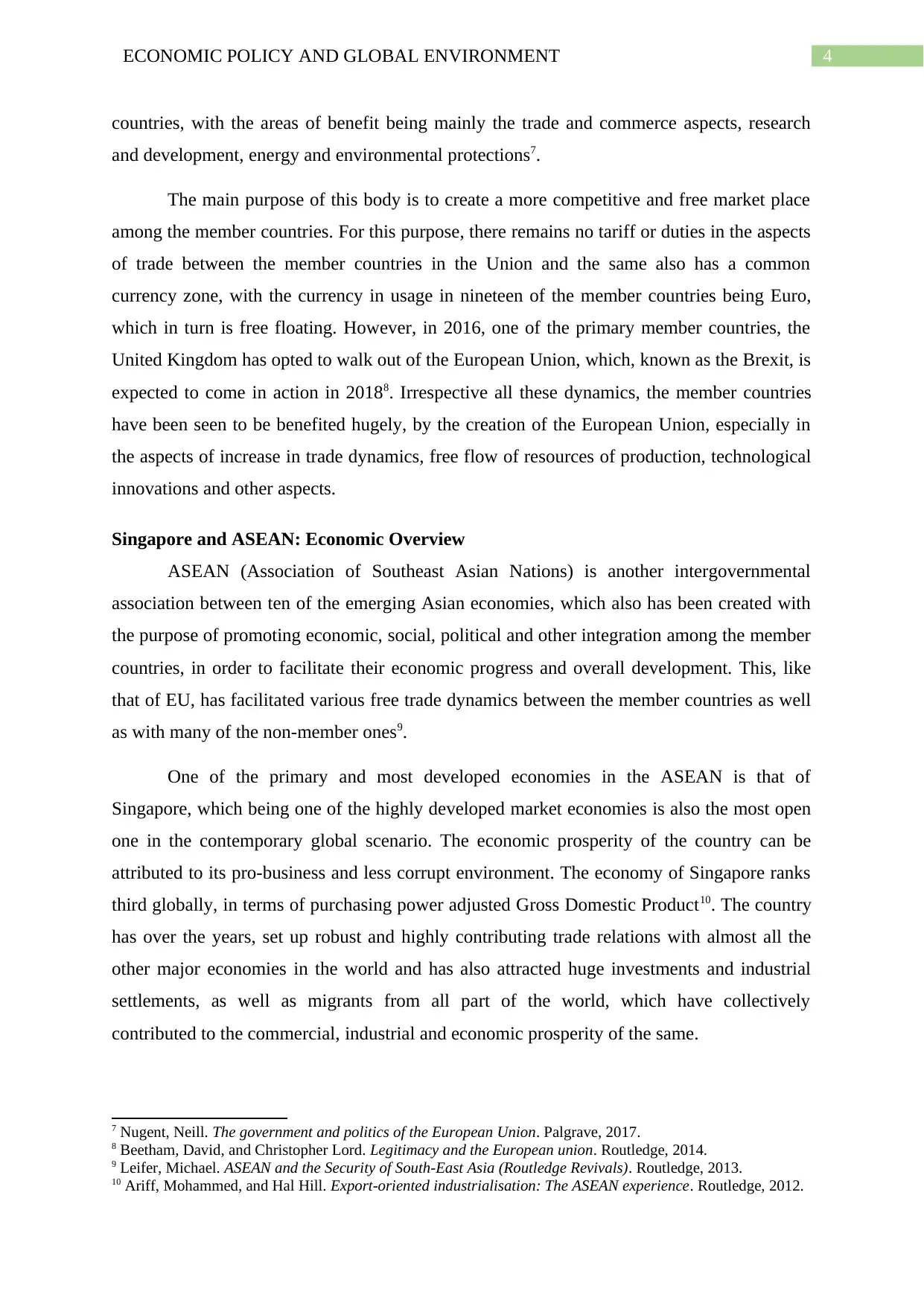
4ECONOMIC POLICY AND GLOBAL ENVIRONMENT
countries, with the areas of benefit being mainly the trade and commerce aspects, research
and development, energy and environmental protections7.
The main purpose of this body is to create a more competitive and free market place
among the member countries. For this purpose, there remains no tariff or duties in the aspects
of trade between the member countries in the Union and the same also has a common
currency zone, with the currency in usage in nineteen of the member countries being Euro,
which in turn is free floating. However, in 2016, one of the primary member countries, the
United Kingdom has opted to walk out of the European Union, which, known as the Brexit, is
expected to come in action in 20188. Irrespective all these dynamics, the member countries
have been seen to be benefited hugely, by the creation of the European Union, especially in
the aspects of increase in trade dynamics, free flow of resources of production, technological
innovations and other aspects.
Singapore and ASEAN: Economic Overview
ASEAN (Association of Southeast Asian Nations) is another intergovernmental
association between ten of the emerging Asian economies, which also has been created with
the purpose of promoting economic, social, political and other integration among the member
countries, in order to facilitate their economic progress and overall development. This, like
that of EU, has facilitated various free trade dynamics between the member countries as well
as with many of the non-member ones9.
One of the primary and most developed economies in the ASEAN is that of
Singapore, which being one of the highly developed market economies is also the most open
one in the contemporary global scenario. The economic prosperity of the country can be
attributed to its pro-business and less corrupt environment. The economy of Singapore ranks
third globally, in terms of purchasing power adjusted Gross Domestic Product10. The country
has over the years, set up robust and highly contributing trade relations with almost all the
other major economies in the world and has also attracted huge investments and industrial
settlements, as well as migrants from all part of the world, which have collectively
contributed to the commercial, industrial and economic prosperity of the same.
7 Nugent, Neill. The government and politics of the European Union. Palgrave, 2017.
8 Beetham, David, and Christopher Lord. Legitimacy and the European union. Routledge, 2014.
9 Leifer, Michael. ASEAN and the Security of South-East Asia (Routledge Revivals). Routledge, 2013.
10 Ariff, Mohammed, and Hal Hill. Export-oriented industrialisation: The ASEAN experience. Routledge, 2012.
countries, with the areas of benefit being mainly the trade and commerce aspects, research
and development, energy and environmental protections7.
The main purpose of this body is to create a more competitive and free market place
among the member countries. For this purpose, there remains no tariff or duties in the aspects
of trade between the member countries in the Union and the same also has a common
currency zone, with the currency in usage in nineteen of the member countries being Euro,
which in turn is free floating. However, in 2016, one of the primary member countries, the
United Kingdom has opted to walk out of the European Union, which, known as the Brexit, is
expected to come in action in 20188. Irrespective all these dynamics, the member countries
have been seen to be benefited hugely, by the creation of the European Union, especially in
the aspects of increase in trade dynamics, free flow of resources of production, technological
innovations and other aspects.
Singapore and ASEAN: Economic Overview
ASEAN (Association of Southeast Asian Nations) is another intergovernmental
association between ten of the emerging Asian economies, which also has been created with
the purpose of promoting economic, social, political and other integration among the member
countries, in order to facilitate their economic progress and overall development. This, like
that of EU, has facilitated various free trade dynamics between the member countries as well
as with many of the non-member ones9.
One of the primary and most developed economies in the ASEAN is that of
Singapore, which being one of the highly developed market economies is also the most open
one in the contemporary global scenario. The economic prosperity of the country can be
attributed to its pro-business and less corrupt environment. The economy of Singapore ranks
third globally, in terms of purchasing power adjusted Gross Domestic Product10. The country
has over the years, set up robust and highly contributing trade relations with almost all the
other major economies in the world and has also attracted huge investments and industrial
settlements, as well as migrants from all part of the world, which have collectively
contributed to the commercial, industrial and economic prosperity of the same.
7 Nugent, Neill. The government and politics of the European Union. Palgrave, 2017.
8 Beetham, David, and Christopher Lord. Legitimacy and the European union. Routledge, 2014.
9 Leifer, Michael. ASEAN and the Security of South-East Asia (Routledge Revivals). Routledge, 2013.
10 Ariff, Mohammed, and Hal Hill. Export-oriented industrialisation: The ASEAN experience. Routledge, 2012.

5ECONOMIC POLICY AND GLOBAL ENVIRONMENT
Trade relationships between European Union and Singapore
The European countries, especially those in the European Union and the economy of
Singapore have already set up robust trade and commercial ties with each other, which have,
over the years, contributed in building up the industrial sectors and facilitated in multilateral
dynamics of not only goods and services but also investments, technologies and other factors
of production among Singapore and the various member countries of the European Union.
Singapore is currently the fourteenth largest trading partners of the European Union
(in terms of trade in different products). Apart from the same, the economy of Singapore is
the largest trading partner of the European Union, among all the member countries of the
ASEAN, as can be seen from the following table:
Table 1: Export and Import relationships of ASEAN countries with the European
Union11
As can be seen from the above figure, the economy of Singapore poses as both the
largest importer (both in terms of goods and services) as well as the largest exporter (both in
terms of goods and services) of the ASEAN, for that of the European Union. This is not
however only the case in terms of goods and services imports and exports12. The same trend
11 Eibn.org. "Indonesia Growth Opportunity and Market Expansion". Eibn.org, 2018. Online. Internet. 8 Jun.
2018. . Available: http://www.eibn.org/en/page/asean_content/50.
12 Ewing-Chow, Michael, Junianto James Losari, and Melania Vilarasau Slade. "The facilitation of trade by the
rule of law: the cases of Singapore and ASEAN." to global markets(2014): 129.
Trade relationships between European Union and Singapore
The European countries, especially those in the European Union and the economy of
Singapore have already set up robust trade and commercial ties with each other, which have,
over the years, contributed in building up the industrial sectors and facilitated in multilateral
dynamics of not only goods and services but also investments, technologies and other factors
of production among Singapore and the various member countries of the European Union.
Singapore is currently the fourteenth largest trading partners of the European Union
(in terms of trade in different products). Apart from the same, the economy of Singapore is
the largest trading partner of the European Union, among all the member countries of the
ASEAN, as can be seen from the following table:
Table 1: Export and Import relationships of ASEAN countries with the European
Union11
As can be seen from the above figure, the economy of Singapore poses as both the
largest importer (both in terms of goods and services) as well as the largest exporter (both in
terms of goods and services) of the ASEAN, for that of the European Union. This is not
however only the case in terms of goods and services imports and exports12. The same trend
11 Eibn.org. "Indonesia Growth Opportunity and Market Expansion". Eibn.org, 2018. Online. Internet. 8 Jun.
2018. . Available: http://www.eibn.org/en/page/asean_content/50.
12 Ewing-Chow, Michael, Junianto James Losari, and Melania Vilarasau Slade. "The facilitation of trade by the
rule of law: the cases of Singapore and ASEAN." to global markets(2014): 129.
⊘ This is a preview!⊘
Do you want full access?
Subscribe today to unlock all pages.

Trusted by 1+ million students worldwide
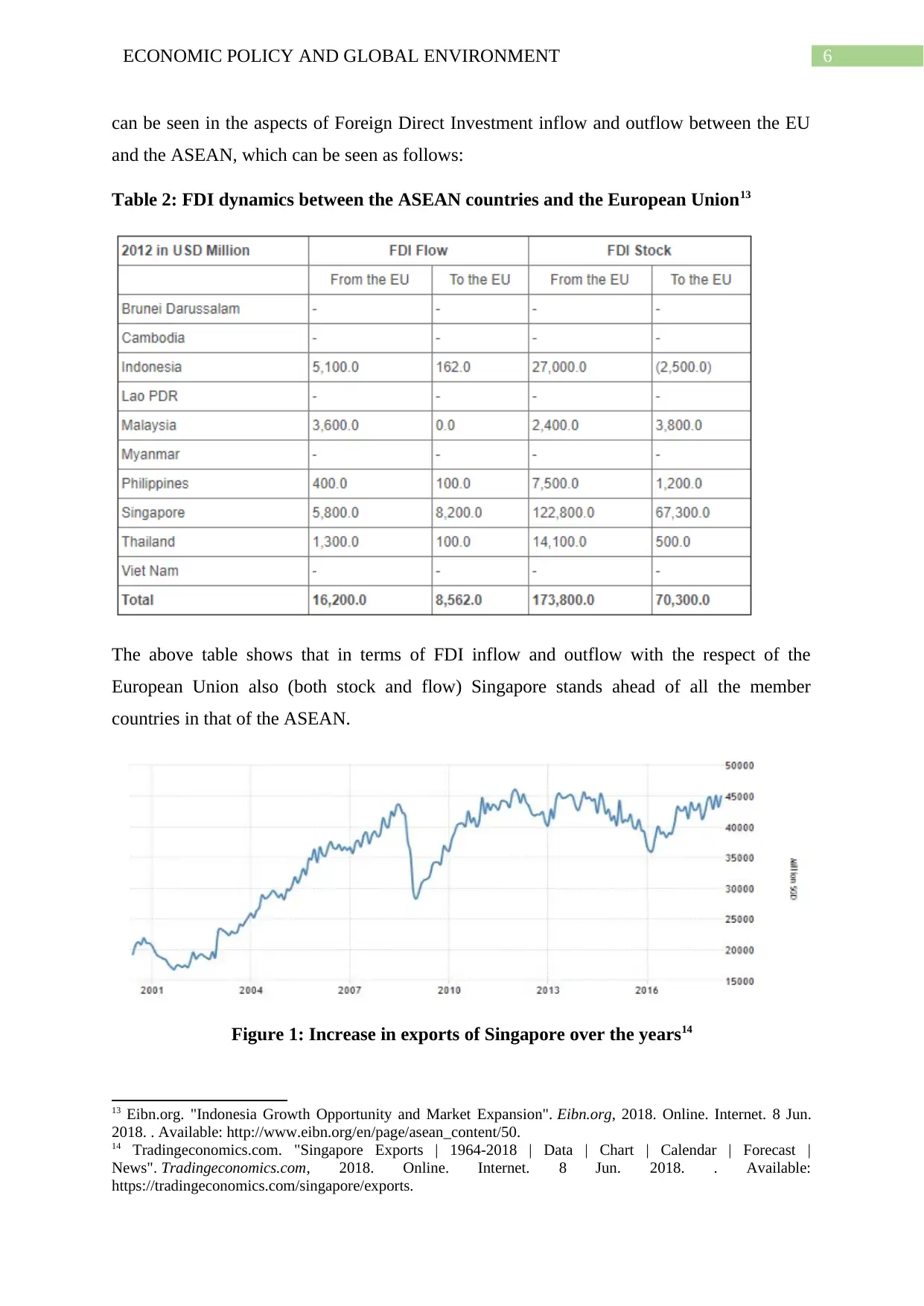
6ECONOMIC POLICY AND GLOBAL ENVIRONMENT
can be seen in the aspects of Foreign Direct Investment inflow and outflow between the EU
and the ASEAN, which can be seen as follows:
Table 2: FDI dynamics between the ASEAN countries and the European Union13
The above table shows that in terms of FDI inflow and outflow with the respect of the
European Union also (both stock and flow) Singapore stands ahead of all the member
countries in that of the ASEAN.
Figure 1: Increase in exports of Singapore over the years14
13 Eibn.org. "Indonesia Growth Opportunity and Market Expansion". Eibn.org, 2018. Online. Internet. 8 Jun.
2018. . Available: http://www.eibn.org/en/page/asean_content/50.
14 Tradingeconomics.com. "Singapore Exports | 1964-2018 | Data | Chart | Calendar | Forecast |
News". Tradingeconomics.com, 2018. Online. Internet. 8 Jun. 2018. . Available:
https://tradingeconomics.com/singapore/exports.
can be seen in the aspects of Foreign Direct Investment inflow and outflow between the EU
and the ASEAN, which can be seen as follows:
Table 2: FDI dynamics between the ASEAN countries and the European Union13
The above table shows that in terms of FDI inflow and outflow with the respect of the
European Union also (both stock and flow) Singapore stands ahead of all the member
countries in that of the ASEAN.
Figure 1: Increase in exports of Singapore over the years14
13 Eibn.org. "Indonesia Growth Opportunity and Market Expansion". Eibn.org, 2018. Online. Internet. 8 Jun.
2018. . Available: http://www.eibn.org/en/page/asean_content/50.
14 Tradingeconomics.com. "Singapore Exports | 1964-2018 | Data | Chart | Calendar | Forecast |
News". Tradingeconomics.com, 2018. Online. Internet. 8 Jun. 2018. . Available:
https://tradingeconomics.com/singapore/exports.
Paraphrase This Document
Need a fresh take? Get an instant paraphrase of this document with our AI Paraphraser

7ECONOMIC POLICY AND GLOBAL ENVIRONMENT
The volume of exports of Singapore can be seen to be showing a visibly positive trend
over the last few years, much of which can be attributed to the robust trade and economic
relationship between Singapore and the European Union. The development of the economic
union of the 28 European countries and the creation of the common trade and currency zone
for the same has also facilitated in creating a huge and comprehensive marketplace, with
diverse demand and supply dynamics, which in turn has benefited the economy of Singapore,
both in terms of exports and imports over the years, as can be seen from the following figure:
Figure 1: Import and export dynamics between the EU and Singapore15
As is evident from the above figure, over the last few years, Singapore has exported
huge amount of goods (of valuation of nearly 20 billion) and imported higher amount of
goods (of valuation of more than 25 billion and increasing with time)16. The trade balance
however, can be seen, to be positive for the European Union. In the aspects of services also,
the exports of the concerned country to the member countries of the EU, can be seen to be
15 Ec.europa.eu. "Singapore - Trade - European Commission". Ec.europa.eu, 2018. Online. Internet. 8 Jun. 2018.
. Available: http://ec.europa.eu/trade/policy/countries-and-regions/countries/singapore/.
16 Hill, Christopher, and Sophie Vanhoonacker. International relations and the European Union. Oxford
University Press, 2017.
The volume of exports of Singapore can be seen to be showing a visibly positive trend
over the last few years, much of which can be attributed to the robust trade and economic
relationship between Singapore and the European Union. The development of the economic
union of the 28 European countries and the creation of the common trade and currency zone
for the same has also facilitated in creating a huge and comprehensive marketplace, with
diverse demand and supply dynamics, which in turn has benefited the economy of Singapore,
both in terms of exports and imports over the years, as can be seen from the following figure:
Figure 1: Import and export dynamics between the EU and Singapore15
As is evident from the above figure, over the last few years, Singapore has exported
huge amount of goods (of valuation of nearly 20 billion) and imported higher amount of
goods (of valuation of more than 25 billion and increasing with time)16. The trade balance
however, can be seen, to be positive for the European Union. In the aspects of services also,
the exports of the concerned country to the member countries of the EU, can be seen to be
15 Ec.europa.eu. "Singapore - Trade - European Commission". Ec.europa.eu, 2018. Online. Internet. 8 Jun. 2018.
. Available: http://ec.europa.eu/trade/policy/countries-and-regions/countries/singapore/.
16 Hill, Christopher, and Sophie Vanhoonacker. International relations and the European Union. Oxford
University Press, 2017.
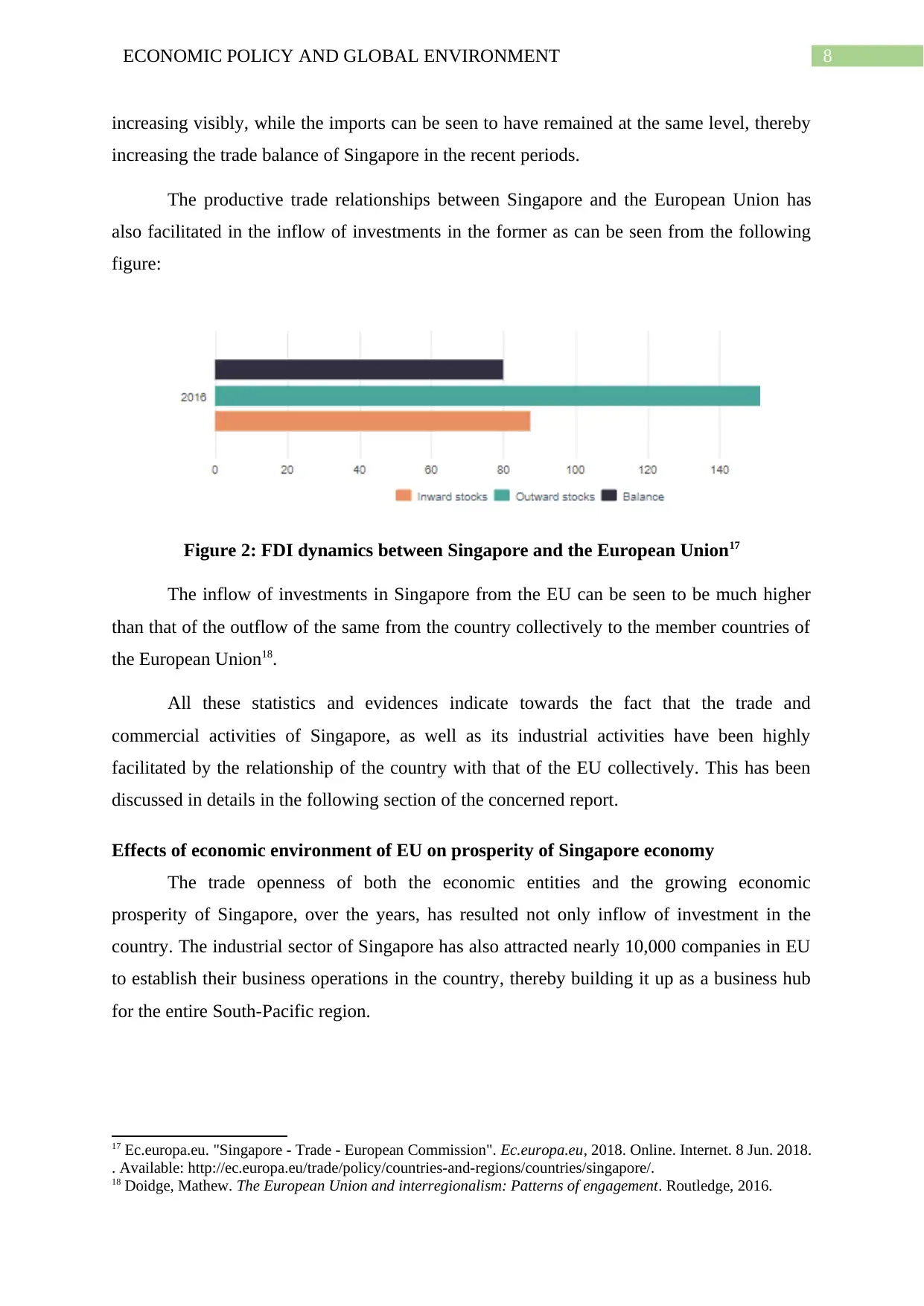
8ECONOMIC POLICY AND GLOBAL ENVIRONMENT
increasing visibly, while the imports can be seen to have remained at the same level, thereby
increasing the trade balance of Singapore in the recent periods.
The productive trade relationships between Singapore and the European Union has
also facilitated in the inflow of investments in the former as can be seen from the following
figure:
Figure 2: FDI dynamics between Singapore and the European Union17
The inflow of investments in Singapore from the EU can be seen to be much higher
than that of the outflow of the same from the country collectively to the member countries of
the European Union18.
All these statistics and evidences indicate towards the fact that the trade and
commercial activities of Singapore, as well as its industrial activities have been highly
facilitated by the relationship of the country with that of the EU collectively. This has been
discussed in details in the following section of the concerned report.
Effects of economic environment of EU on prosperity of Singapore economy
The trade openness of both the economic entities and the growing economic
prosperity of Singapore, over the years, has resulted not only inflow of investment in the
country. The industrial sector of Singapore has also attracted nearly 10,000 companies in EU
to establish their business operations in the country, thereby building it up as a business hub
for the entire South-Pacific region.
17 Ec.europa.eu. "Singapore - Trade - European Commission". Ec.europa.eu, 2018. Online. Internet. 8 Jun. 2018.
. Available: http://ec.europa.eu/trade/policy/countries-and-regions/countries/singapore/.
18 Doidge, Mathew. The European Union and interregionalism: Patterns of engagement. Routledge, 2016.
increasing visibly, while the imports can be seen to have remained at the same level, thereby
increasing the trade balance of Singapore in the recent periods.
The productive trade relationships between Singapore and the European Union has
also facilitated in the inflow of investments in the former as can be seen from the following
figure:
Figure 2: FDI dynamics between Singapore and the European Union17
The inflow of investments in Singapore from the EU can be seen to be much higher
than that of the outflow of the same from the country collectively to the member countries of
the European Union18.
All these statistics and evidences indicate towards the fact that the trade and
commercial activities of Singapore, as well as its industrial activities have been highly
facilitated by the relationship of the country with that of the EU collectively. This has been
discussed in details in the following section of the concerned report.
Effects of economic environment of EU on prosperity of Singapore economy
The trade openness of both the economic entities and the growing economic
prosperity of Singapore, over the years, has resulted not only inflow of investment in the
country. The industrial sector of Singapore has also attracted nearly 10,000 companies in EU
to establish their business operations in the country, thereby building it up as a business hub
for the entire South-Pacific region.
17 Ec.europa.eu. "Singapore - Trade - European Commission". Ec.europa.eu, 2018. Online. Internet. 8 Jun. 2018.
. Available: http://ec.europa.eu/trade/policy/countries-and-regions/countries/singapore/.
18 Doidge, Mathew. The European Union and interregionalism: Patterns of engagement. Routledge, 2016.
⊘ This is a preview!⊘
Do you want full access?
Subscribe today to unlock all pages.

Trusted by 1+ million students worldwide
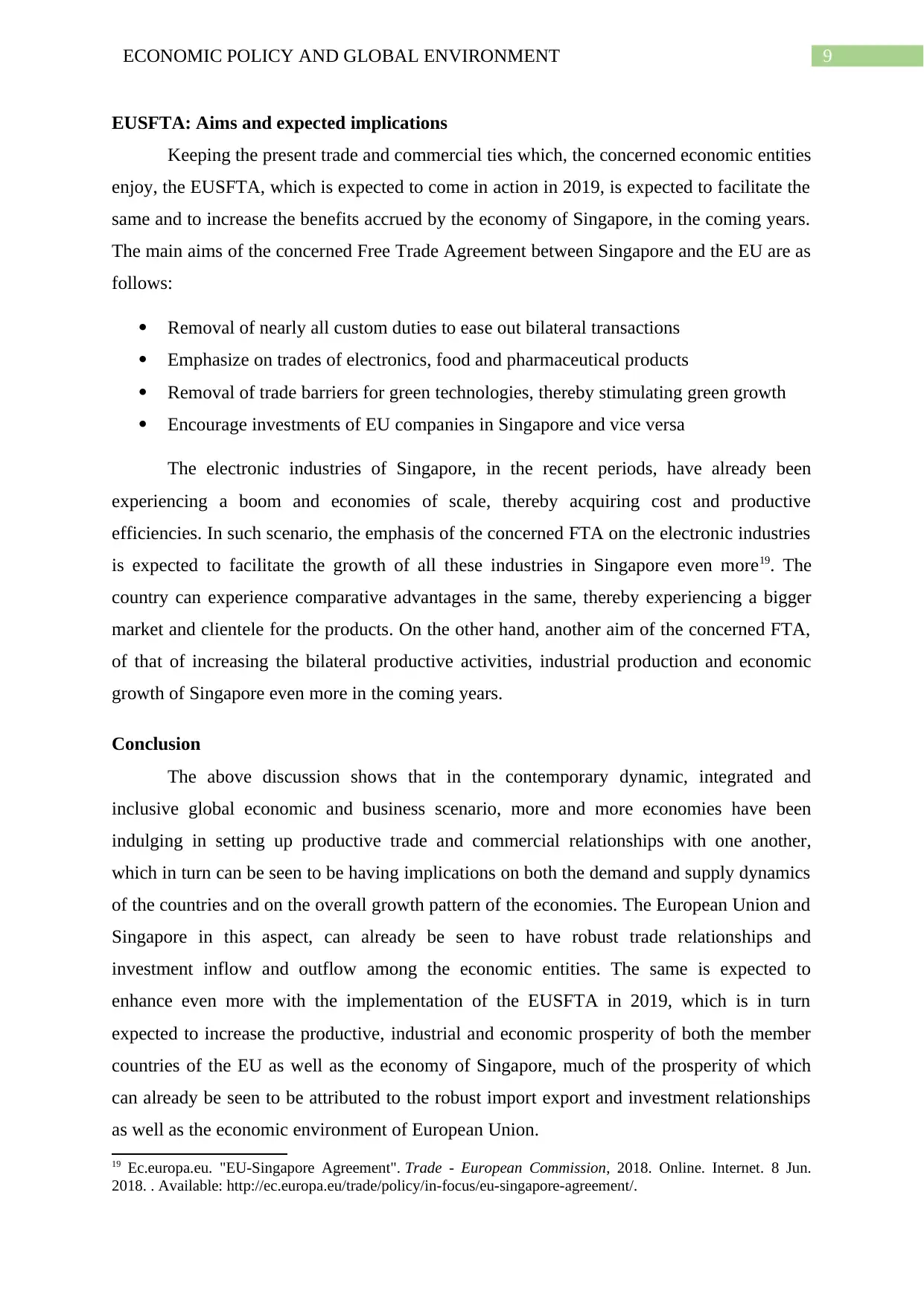
9ECONOMIC POLICY AND GLOBAL ENVIRONMENT
EUSFTA: Aims and expected implications
Keeping the present trade and commercial ties which, the concerned economic entities
enjoy, the EUSFTA, which is expected to come in action in 2019, is expected to facilitate the
same and to increase the benefits accrued by the economy of Singapore, in the coming years.
The main aims of the concerned Free Trade Agreement between Singapore and the EU are as
follows:
Removal of nearly all custom duties to ease out bilateral transactions
Emphasize on trades of electronics, food and pharmaceutical products
Removal of trade barriers for green technologies, thereby stimulating green growth
Encourage investments of EU companies in Singapore and vice versa
The electronic industries of Singapore, in the recent periods, have already been
experiencing a boom and economies of scale, thereby acquiring cost and productive
efficiencies. In such scenario, the emphasis of the concerned FTA on the electronic industries
is expected to facilitate the growth of all these industries in Singapore even more19. The
country can experience comparative advantages in the same, thereby experiencing a bigger
market and clientele for the products. On the other hand, another aim of the concerned FTA,
of that of increasing the bilateral productive activities, industrial production and economic
growth of Singapore even more in the coming years.
Conclusion
The above discussion shows that in the contemporary dynamic, integrated and
inclusive global economic and business scenario, more and more economies have been
indulging in setting up productive trade and commercial relationships with one another,
which in turn can be seen to be having implications on both the demand and supply dynamics
of the countries and on the overall growth pattern of the economies. The European Union and
Singapore in this aspect, can already be seen to have robust trade relationships and
investment inflow and outflow among the economic entities. The same is expected to
enhance even more with the implementation of the EUSFTA in 2019, which is in turn
expected to increase the productive, industrial and economic prosperity of both the member
countries of the EU as well as the economy of Singapore, much of the prosperity of which
can already be seen to be attributed to the robust import export and investment relationships
as well as the economic environment of European Union.
19 Ec.europa.eu. "EU-Singapore Agreement". Trade - European Commission, 2018. Online. Internet. 8 Jun.
2018. . Available: http://ec.europa.eu/trade/policy/in-focus/eu-singapore-agreement/.
EUSFTA: Aims and expected implications
Keeping the present trade and commercial ties which, the concerned economic entities
enjoy, the EUSFTA, which is expected to come in action in 2019, is expected to facilitate the
same and to increase the benefits accrued by the economy of Singapore, in the coming years.
The main aims of the concerned Free Trade Agreement between Singapore and the EU are as
follows:
Removal of nearly all custom duties to ease out bilateral transactions
Emphasize on trades of electronics, food and pharmaceutical products
Removal of trade barriers for green technologies, thereby stimulating green growth
Encourage investments of EU companies in Singapore and vice versa
The electronic industries of Singapore, in the recent periods, have already been
experiencing a boom and economies of scale, thereby acquiring cost and productive
efficiencies. In such scenario, the emphasis of the concerned FTA on the electronic industries
is expected to facilitate the growth of all these industries in Singapore even more19. The
country can experience comparative advantages in the same, thereby experiencing a bigger
market and clientele for the products. On the other hand, another aim of the concerned FTA,
of that of increasing the bilateral productive activities, industrial production and economic
growth of Singapore even more in the coming years.
Conclusion
The above discussion shows that in the contemporary dynamic, integrated and
inclusive global economic and business scenario, more and more economies have been
indulging in setting up productive trade and commercial relationships with one another,
which in turn can be seen to be having implications on both the demand and supply dynamics
of the countries and on the overall growth pattern of the economies. The European Union and
Singapore in this aspect, can already be seen to have robust trade relationships and
investment inflow and outflow among the economic entities. The same is expected to
enhance even more with the implementation of the EUSFTA in 2019, which is in turn
expected to increase the productive, industrial and economic prosperity of both the member
countries of the EU as well as the economy of Singapore, much of the prosperity of which
can already be seen to be attributed to the robust import export and investment relationships
as well as the economic environment of European Union.
19 Ec.europa.eu. "EU-Singapore Agreement". Trade - European Commission, 2018. Online. Internet. 8 Jun.
2018. . Available: http://ec.europa.eu/trade/policy/in-focus/eu-singapore-agreement/.
Paraphrase This Document
Need a fresh take? Get an instant paraphrase of this document with our AI Paraphraser
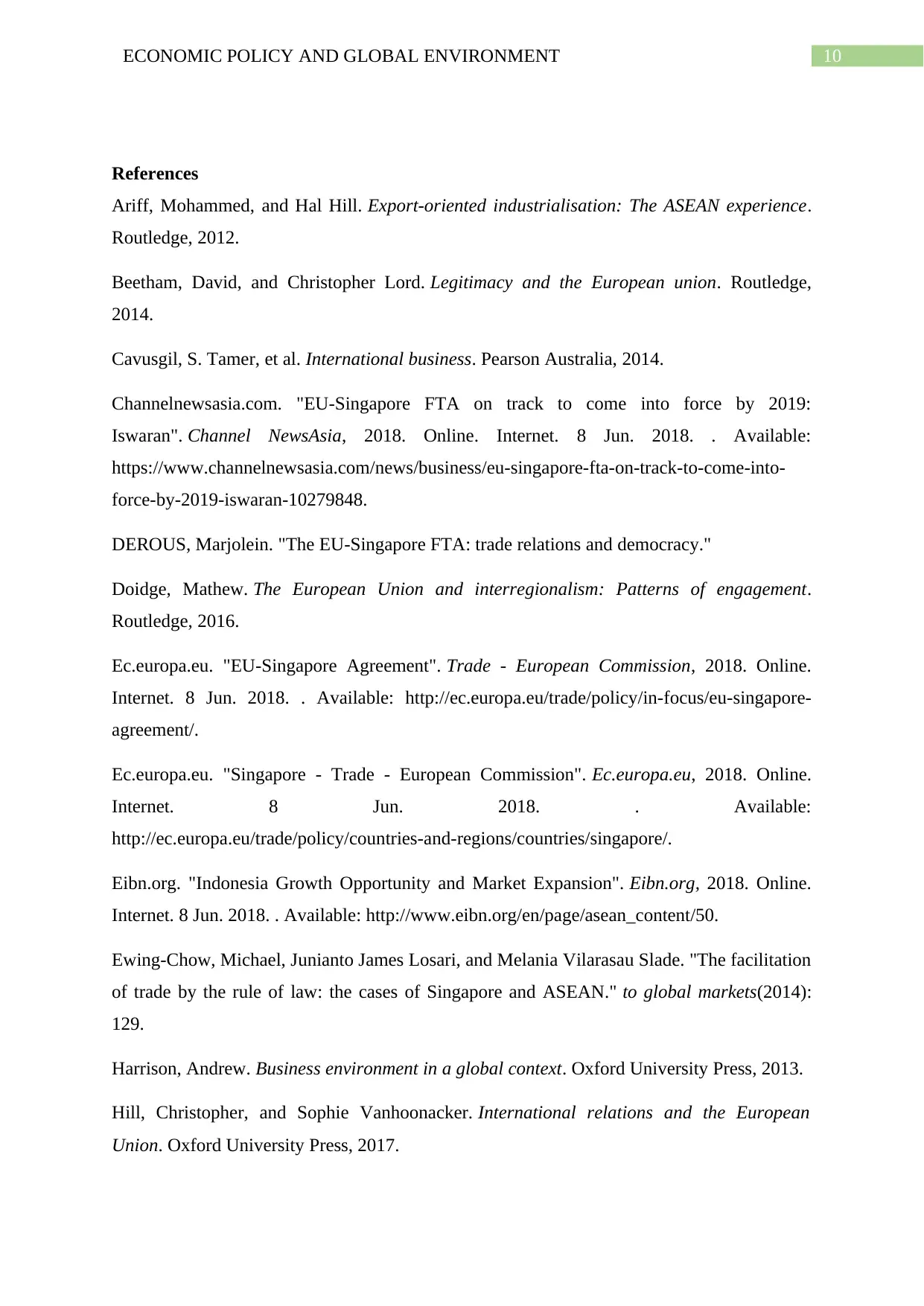
10ECONOMIC POLICY AND GLOBAL ENVIRONMENT
References
Ariff, Mohammed, and Hal Hill. Export-oriented industrialisation: The ASEAN experience.
Routledge, 2012.
Beetham, David, and Christopher Lord. Legitimacy and the European union. Routledge,
2014.
Cavusgil, S. Tamer, et al. International business. Pearson Australia, 2014.
Channelnewsasia.com. "EU-Singapore FTA on track to come into force by 2019:
Iswaran". Channel NewsAsia, 2018. Online. Internet. 8 Jun. 2018. . Available:
https://www.channelnewsasia.com/news/business/eu-singapore-fta-on-track-to-come-into-
force-by-2019-iswaran-10279848.
DEROUS, Marjolein. "The EU-Singapore FTA: trade relations and democracy."
Doidge, Mathew. The European Union and interregionalism: Patterns of engagement.
Routledge, 2016.
Ec.europa.eu. "EU-Singapore Agreement". Trade - European Commission, 2018. Online.
Internet. 8 Jun. 2018. . Available: http://ec.europa.eu/trade/policy/in-focus/eu-singapore-
agreement/.
Ec.europa.eu. "Singapore - Trade - European Commission". Ec.europa.eu, 2018. Online.
Internet. 8 Jun. 2018. . Available:
http://ec.europa.eu/trade/policy/countries-and-regions/countries/singapore/.
Eibn.org. "Indonesia Growth Opportunity and Market Expansion". Eibn.org, 2018. Online.
Internet. 8 Jun. 2018. . Available: http://www.eibn.org/en/page/asean_content/50.
Ewing-Chow, Michael, Junianto James Losari, and Melania Vilarasau Slade. "The facilitation
of trade by the rule of law: the cases of Singapore and ASEAN." to global markets(2014):
129.
Harrison, Andrew. Business environment in a global context. Oxford University Press, 2013.
Hill, Christopher, and Sophie Vanhoonacker. International relations and the European
Union. Oxford University Press, 2017.
References
Ariff, Mohammed, and Hal Hill. Export-oriented industrialisation: The ASEAN experience.
Routledge, 2012.
Beetham, David, and Christopher Lord. Legitimacy and the European union. Routledge,
2014.
Cavusgil, S. Tamer, et al. International business. Pearson Australia, 2014.
Channelnewsasia.com. "EU-Singapore FTA on track to come into force by 2019:
Iswaran". Channel NewsAsia, 2018. Online. Internet. 8 Jun. 2018. . Available:
https://www.channelnewsasia.com/news/business/eu-singapore-fta-on-track-to-come-into-
force-by-2019-iswaran-10279848.
DEROUS, Marjolein. "The EU-Singapore FTA: trade relations and democracy."
Doidge, Mathew. The European Union and interregionalism: Patterns of engagement.
Routledge, 2016.
Ec.europa.eu. "EU-Singapore Agreement". Trade - European Commission, 2018. Online.
Internet. 8 Jun. 2018. . Available: http://ec.europa.eu/trade/policy/in-focus/eu-singapore-
agreement/.
Ec.europa.eu. "Singapore - Trade - European Commission". Ec.europa.eu, 2018. Online.
Internet. 8 Jun. 2018. . Available:
http://ec.europa.eu/trade/policy/countries-and-regions/countries/singapore/.
Eibn.org. "Indonesia Growth Opportunity and Market Expansion". Eibn.org, 2018. Online.
Internet. 8 Jun. 2018. . Available: http://www.eibn.org/en/page/asean_content/50.
Ewing-Chow, Michael, Junianto James Losari, and Melania Vilarasau Slade. "The facilitation
of trade by the rule of law: the cases of Singapore and ASEAN." to global markets(2014):
129.
Harrison, Andrew. Business environment in a global context. Oxford University Press, 2013.
Hill, Christopher, and Sophie Vanhoonacker. International relations and the European
Union. Oxford University Press, 2017.
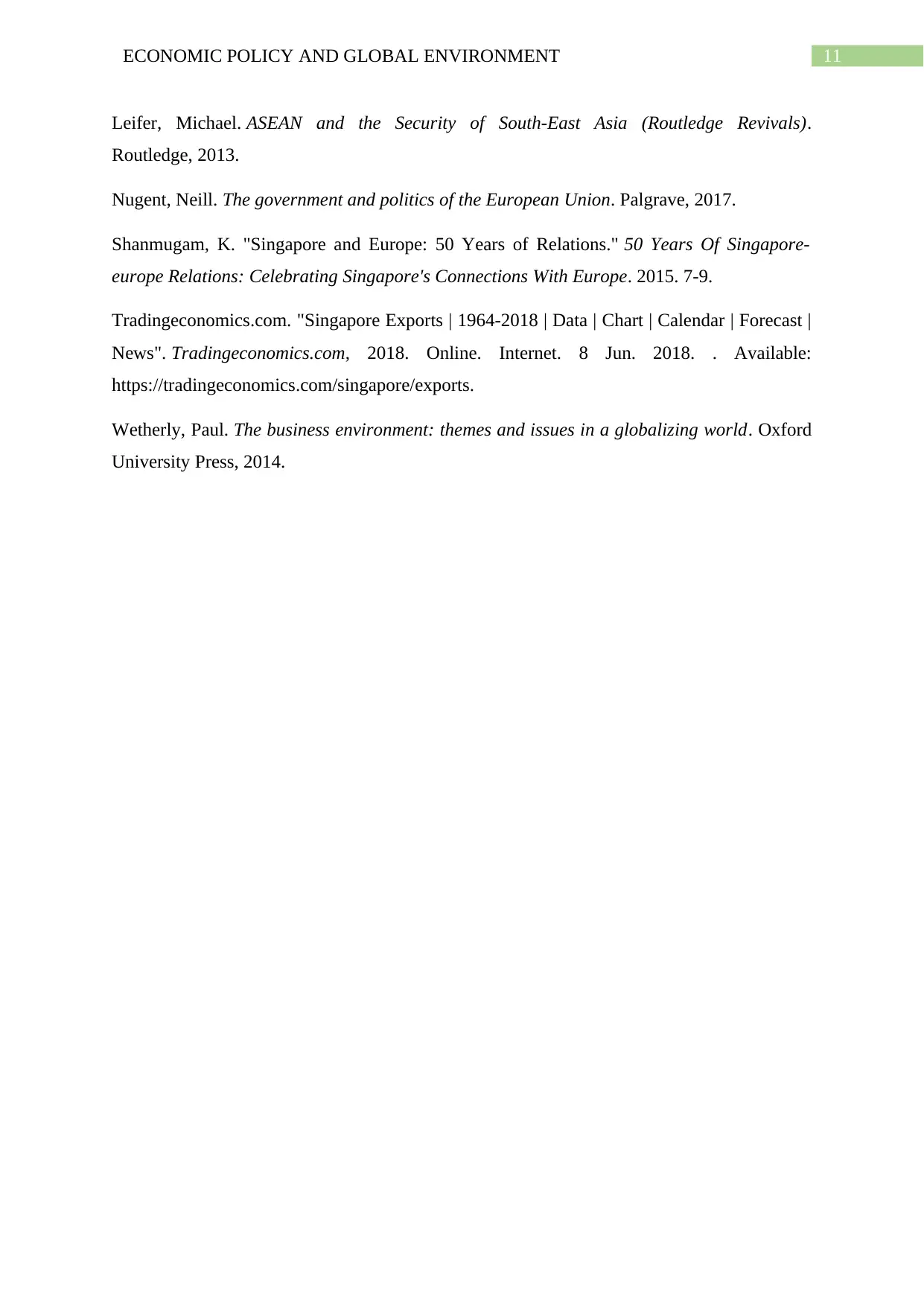
11ECONOMIC POLICY AND GLOBAL ENVIRONMENT
Leifer, Michael. ASEAN and the Security of South-East Asia (Routledge Revivals).
Routledge, 2013.
Nugent, Neill. The government and politics of the European Union. Palgrave, 2017.
Shanmugam, K. "Singapore and Europe: 50 Years of Relations." 50 Years Of Singapore-
europe Relations: Celebrating Singapore's Connections With Europe. 2015. 7-9.
Tradingeconomics.com. "Singapore Exports | 1964-2018 | Data | Chart | Calendar | Forecast |
News". Tradingeconomics.com, 2018. Online. Internet. 8 Jun. 2018. . Available:
https://tradingeconomics.com/singapore/exports.
Wetherly, Paul. The business environment: themes and issues in a globalizing world. Oxford
University Press, 2014.
Leifer, Michael. ASEAN and the Security of South-East Asia (Routledge Revivals).
Routledge, 2013.
Nugent, Neill. The government and politics of the European Union. Palgrave, 2017.
Shanmugam, K. "Singapore and Europe: 50 Years of Relations." 50 Years Of Singapore-
europe Relations: Celebrating Singapore's Connections With Europe. 2015. 7-9.
Tradingeconomics.com. "Singapore Exports | 1964-2018 | Data | Chart | Calendar | Forecast |
News". Tradingeconomics.com, 2018. Online. Internet. 8 Jun. 2018. . Available:
https://tradingeconomics.com/singapore/exports.
Wetherly, Paul. The business environment: themes and issues in a globalizing world. Oxford
University Press, 2014.
⊘ This is a preview!⊘
Do you want full access?
Subscribe today to unlock all pages.

Trusted by 1+ million students worldwide
1 out of 12
Related Documents
Your All-in-One AI-Powered Toolkit for Academic Success.
+13062052269
info@desklib.com
Available 24*7 on WhatsApp / Email
![[object Object]](/_next/static/media/star-bottom.7253800d.svg)
Unlock your academic potential
Copyright © 2020–2025 A2Z Services. All Rights Reserved. Developed and managed by ZUCOL.




